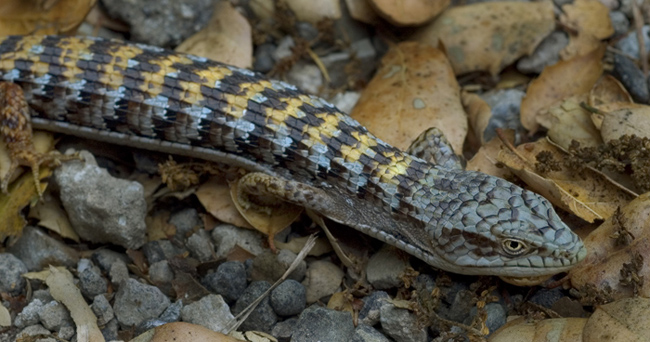
Interactions
Territorial Size and Behavior? The
northern alligator lizard is a non-seasonal migrator traveling
less than half a mile throughout the year. Because of this
relatively small territory size, the alligator lizard exhibits
territorial behavior, protecting its home and habitat. A term to
describe this behavior is “site tenacious” (McBrayer and
Anderson 2007). The northern alligator lizard does not live
alone; many other species of animals coexist within the same
habitat. Examples of animals coexisting with the northern
alligator lizard include hawks (specifically the
red-tailed
hawk), snakes, shrikes (small birds of prey),owls,
weasels, domestic
cats and
sometimes even humans. These lizards can be feisty when
confronted by predators and have a few techniques to fend off or
escape them. If threatened, alligator lizards will open there
mouths, showing off their teeth and may try to bite or defecate
on the predator (McBrayer and Anderson 2007).

Another impressive escape technique exhibited by the alligator lizard is the ability to shed part of its tail. When attacked they can quickly cast away part of their tall without injury, leaving behind a still wiggling tail as a distraction. Species interaction (Competitive and Predatory) Northern alligator lizards are preyed upon by a number of different animals. Hawks and shrikes are two of the main birds of prey that consume the alligator lizard. Snakes are another predator, living in the same habitat under rocks, wood, grass, and bushes (Hayes and Hayes 2008). It is hard for alligator lizards to avoid these snakes because unlike birds, the snakes are able to slither under the cover and find these lizards in their homes. Alligator lizards living in residential areas are prone to being consumed by domestic cats, which catch and eat them when they emerge from their rock or timber cover.
The alligator lizard however is a predator itself, consuming a variety of different animals and insects. Northern alligator lizards are carnivorous, meaning they consume meat(McBrayer and Anderson 2007). Insects and other arthropods that they ingest include: beetles, grasshoppers, crickets, centipedes, wasps and spiders. Other organisms ingested by the alligator lizard are snails, tadpoles, other lizards and sometimes even their own young. Competition for food and nutrients is present, primarily between the northern and southern alligator lizards, and also western skinks. All three of these species are small, scaled lizards that possess similar body styles and functions. Due to the fact that they all share the same habitat, they must compete for the same prey types. The northern alligator lizard obtains its food during the day, while it is warm out. Quick, rapid strikes of the lizards head provide the necessary motions to capture their prey (Hayes and Hayes 2008). In relation to the food web, the northern alligator lizard is relatively low, consuming small organisms but being preyed upon by a large number of animals. These lizards play a small role in relation to human life and use, with no vital relationships between the two.